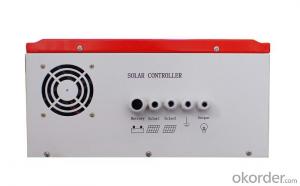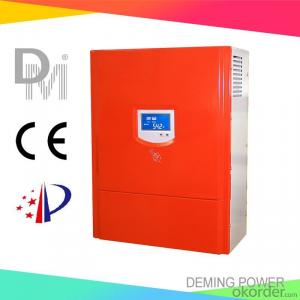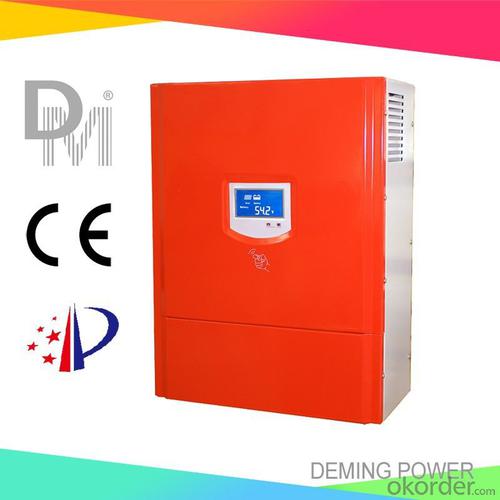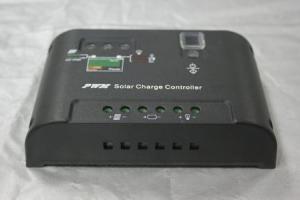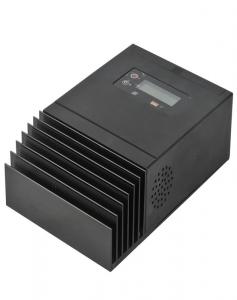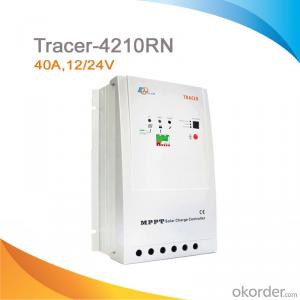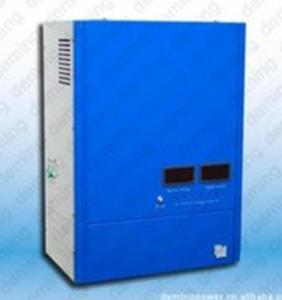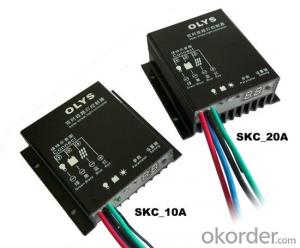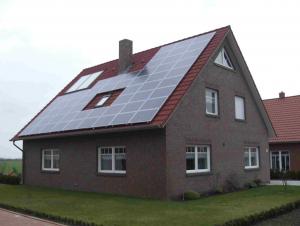2 Solar Charge Controllers MPPT Solar Charge Controller 96V 30A with Best Price for Solar Power System
- Loading Port:
- Qingdao
- Payment Terms:
- TT or LC
- Min Order Qty:
- 1 PCS
- Supply Capability:
- 1000 PCS/month
OKorder Service Pledge
OKorder Financial Service
You Might Also Like
Properties of the solar charge controller
1. Design for off-grid solar power system.
2. Applicable to different kinds of batteries.
3. Modular design with simple structure and easy maintenance.
4. LCD display: Solar panel current, solar panel voltage, solar panel power, battery group voltage, charge current.
Technical parameters of the solar charge controller
Model | 96V30A | |||||
Battery group rated voltage | 96Vdc | |||||
PV Rated current | 30A | |||||
PV open circuit voltage | 400V | |||||
PV Max. power | 2880Wp | |||||
Input PV module road number | 1 | |||||
Function | MPPT charge mode, auto stop charge, auto recharge voltage; Protection: connecting contrary, over current, short circuit, over heat etc. | |||||
Display mode | LCD | |||||
Display content | solar panel voltage, solar panel current, solar panel power, battery voltage, charge current | |||||
MPPT DC voltage rang | 80-116Vdc | |||||
Floating Charge Voltage (adjustable) | 110Vdc | |||||
Stop charge voltage | 116Vdc±1% | |||||
Recharge voltage | 108V±1% | |||||
Voltage drop between PV and battery | 1.5V | |||||
Max itself power consumption | 100mA-150mA | |||||
Work environment temperature | -30-60°C | |||||
Relative humidity | 90% No condensation | |||||
Applicable altitude | 3000m The rated power should be reduced when it is higher than 2000m | |||||
Noise (1m) | 40dB | |||||
Degree of protection | IP20(Indoor) | |||||
Cooling method | Forced air cooling | |||||
*Communication interface (optional) | RS485/USB/GPRS/Ethernet | |||||
*Temperature compensation(optional) | -4mv/°C/2V,-35°C~+80°C,Accuracy:±1°C | |||||
Product size (mm) | 480*370*160mm | |||||
Product Weight(kg) | 12kg | |||||
*Above parameter only for reference. Could be custom made to user specifications.
Image
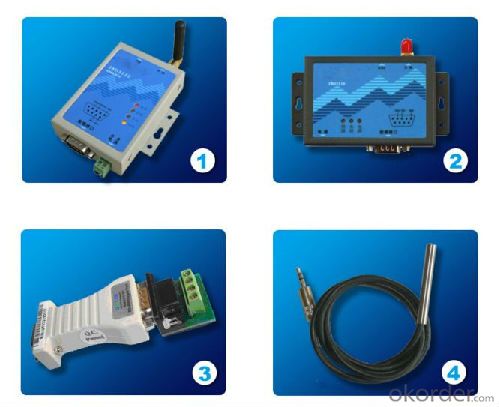
FAQ
Q1:Can we visit your factory? A1:Sure,welcome at any time,seeing is believing. Q2:How to guarantee the Quality of the products? A2:We have established the international advanced Quality management system,every link from raw material to final product we have strict Quality test;We resolutely put an end to unQualified products flowing into the market. At the same time, we will provide necessary follow-up service assurance.
- Q: What is the role of a solar controller in preventing battery memory effect?
- The role of a solar controller in preventing battery memory effect is to regulate and optimize the charging process of the battery. It ensures that the battery is not overcharged or discharged excessively, which helps to prevent the memory effect. By maintaining the battery at the optimal charge level, the solar controller helps to extend the battery lifespan and maximize its performance.
- Q: Can a solar controller be used with solar-powered indoor manufacturing systems?
- Yes, a solar controller can be used with solar-powered indoor manufacturing systems. A solar controller is an essential component of a solar power system as it regulates the flow of electricity between the solar panels and the batteries, ensuring that the batteries are charged efficiently and preventing overcharging or damage to the system. In the case of solar-powered indoor manufacturing systems, the solar controller would still be necessary to manage the flow of energy from the solar panels to the batteries, even if the manufacturing processes are conducted indoors. The solar controller would help optimize the use of solar energy and ensure that the system operates smoothly and efficiently, regardless of the location of the manufacturing facility.
- Q: Can a solar controller be used for both off-grid and grid-tied systems?
- No, a solar controller cannot be used for both off-grid and grid-tied systems. Off-grid solar systems require controllers that can manage the battery charging and discharging process, while grid-tied systems typically do not have batteries and therefore do not require the same control functions. Different types of controllers are designed specifically for each system type to ensure optimal performance and safety.
- Q: What is the maximum voltage rating of a solar controller?
- The maximum voltage rating of a solar controller typically varies depending on the specific model and manufacturer. However, it is commonly found to be around 12V, 24V, or 48V for most standard solar controllers. It is important to refer to the product specifications or consult the manufacturer for the precise maximum voltage rating of a particular solar controller.
- Q: What is the maximum number of communication protocols supported by a solar controller?
- The maximum number of communication protocols supported by a solar controller can vary depending on the specific model and brand. However, it is common for solar controllers to support multiple protocols, including popular ones like RS485, Modbus, and CANbus.
- Q: Can a solar controller be used in conjunction with a solar inverter?
- Yes, a solar controller can be used in conjunction with a solar inverter. A solar controller is responsible for regulating and controlling the flow of electricity from solar panels to batteries, while a solar inverter converts the DC (direct current) power generated by the solar panels into AC (alternating current) power that can be used to power appliances and devices. By working together, a solar controller ensures that the batteries are properly charged and protected, while the solar inverter efficiently converts the solar energy into usable electricity.
- Q: How does a solar controller prevent overloading of the solar panel system?
- Preventing overload in the solar panel system is a crucial function of the solar controller, also known as the charge controller. It ensures that the energy produced by the solar panels is utilized effectively, without causing any harm to the system. To prevent overload, the solar controller constantly monitors the voltage and current levels of the solar panels. It compares the input from the panels with the system's capacity. If the input exceeds the maximum capacity, the controller takes necessary action to prevent overload. There are various techniques employed by the solar controller to prevent overload. One common method is pulse width modulation (PWM). PWM controllers effectively regulate the flow of energy by quickly switching the input current on and off. By controlling the duration of each pulse, the controller ensures that the energy delivered to the system matches the demand, thus preventing overload. Another technique used by solar controllers is maximum power point tracking (MPPT). MPPT controllers optimize the efficiency of the solar panel system by identifying the point at which the panels generate the maximum power output. By continuously adjusting the input voltage and current, the controller ensures that the system operates at its peak performance, effectively preventing overload. Furthermore, solar controllers often incorporate safety features like short-circuit protection and overload protection. These features detect and respond to abnormal situations, such as sudden voltage surges or excessive current, by temporarily shutting down the system or directing the excess energy elsewhere. This ensures the protection of the panels and other components from damage. In conclusion, the solar controller plays a crucial role in preventing overload in the solar panel system. It monitors voltage and current levels, utilizes techniques like PWM and MPPT to regulate energy flow, and incorporates safety features to protect against abnormal situations. Its significance lies in maintaining the efficiency and lifespan of the solar power system.
- Q: Can a solar controller be used with solar-powered indoor ventilation systems?
- Yes, a solar controller can be used with solar-powered indoor ventilation systems. A solar controller regulates the power output from solar panels and ensures the efficient operation of the ventilation system by managing battery charging and maintaining optimal voltage levels.
- Q: What is the maximum load voltage a solar controller can handle?
- The maximum load voltage a solar controller can handle depends on its specifications and design. It can vary from controller to controller, but generally, solar controllers can handle load voltages up to 12 volts or 24 volts, which are common in off-grid solar systems. However, it is important to refer to the specific manufacturer's guidelines to determine the exact maximum load voltage for a particular solar controller model.
- Q: Can a solar controller be used with solar panels of different technologies (e.g., monocrystalline, polycrystalline)?
- Yes, a solar controller can be used with solar panels of different technologies such as monocrystalline and polycrystalline. Solar controllers are designed to regulate the charging process and manage the power flow from the solar panels to the battery or load. They are compatible with various types of solar panels and can efficiently handle the different voltages and currents produced by different technologies.
Send your message to us
2 Solar Charge Controllers MPPT Solar Charge Controller 96V 30A with Best Price for Solar Power System
- Loading Port:
- Qingdao
- Payment Terms:
- TT or LC
- Min Order Qty:
- 1 PCS
- Supply Capability:
- 1000 PCS/month
OKorder Service Pledge
OKorder Financial Service
Similar products
Hot products
Hot Searches
Related keywords
